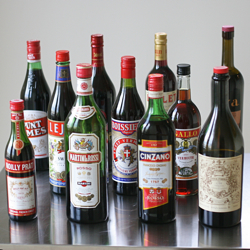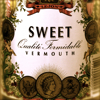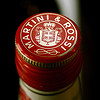A sweet Italian sip
 Restocking the bar in preparation for holiday guests, we found we’d managed to squirrel away no less than four half-empty bottles of sweet vermouth. Shaking our heads at our folly, we decided to figure out which one we liked best and toss the others. Sure, we needed Carpano Antica for our favorite cold-weather Manhattan, but how different could the others be?
Restocking the bar in preparation for holiday guests, we found we’d managed to squirrel away no less than four half-empty bottles of sweet vermouth. Shaking our heads at our folly, we decided to figure out which one we liked best and toss the others. Sure, we needed Carpano Antica for our favorite cold-weather Manhattan, but how different could the others be?
Plenty.
After some quick sips, it became apparent that even among the big three brands — Cinzano, Noilly Pratt, and Martini & Rossi — the differences were astounding. The lone French-made bottle, the Noilly Pratt was the most herbal, and most bitter, of the three …a potent reminder of vermouth’s linguistic origins in “wormwood”. The original sweet vermouths came from Italy — you’ll often see red vermouth referred to as Italian vermouth in old recipes — so it’s not surprising that we felt the Martini and Cinzano brands were closer to our ideal. (Some day we’ll have to check whether the reverse is true: Do the French make better dry vermouth, given its historic roots on the other side of the Alps?)
On our next trip to the liquor warehouse, our eyes were opened. We’d never noticed just how many sweet vermouths were on the shelf! With most bottles priced well under $10, why not round out our collection and get to the bottom of which was best? My sister and her husband were on their way to town, and a sweet vermouth tasting seemed just the ticket for four cocktail aficionados to while away the holiday weekend.
With a stack of shot glasses and a pile of notepads at the ready, the tastings began.
Our first round featured the supermarket stalwarts: Martini & Rossi, Cinzano, and Noilly Pratt (identically priced around town at $5.99 to $7.25). Just as we’d found in our earlier un-juried tasting, the Noilly Prat stood out from the pack: Its “herbal” “bite” was pegged as “very bitter” and “medicinal” by all. Tasted neat, Cinzano’s sweetness was its downfall: We called it “cloying candy” and “marshmallow sweet”, overwhelming its less obvious “citrus and spice” notes. The Martini & Rossi became the bottle to beat, universally praised for its “smooth”, “balanced”, “fruity warmth”.
The lesser-known vermouths in our next tier proved that you mostly get what you pay for. Although the Boissiere ($7.29) was dubbed “not bad” by three tasters, the Gallo ($2.99) rated “foul”, “bad”, and “not pleasant” across the board. The true stinker was Lejon ($3.99), which sent us running for our water glasses: Strong “vinegar” notes and “artificial” flavors earned it a last-place finish: “Blech!” indeed.
Next up, a pair of boutique options. At $29, Carpano Antica’s the priciest of the lot, but it’s a house favorite for good reason. Its “very smooth” profile was noticeably more “spicy and deep” than its mainstream competitors. All of us noted its sweetness, but felt it offered a “chewy”, “caramel” complexity rather than a brash sugar assault. Our local entrant, Vya ($19) showed its “grapey” pedigree — it’s made by Quady, the winery behind the once-trendy Elysium black muscat. With “piney” hints of “juniper” and a “snappy” finish, one taster found it a bit too “menthol” for his palate.
We also tasted a flight of red-wine based aperitifs: The French-made Lillet Rouge and Dubonnet, and the Italian Punt e Mes. Too far off the beaten path to serve as straight replacements for sweet vermouth, they’re more like kissing cousins than actual alternatives. Lillet and Dubonnet were pleasant enough to drink on their own; Punt e Mes found few fans due to its very strong bitterness, although it’s a key ingredient in a handful of cocktails.
As a control, we stirred up a set of Manhattans to see if the differences between brands were too subtle to be noticed in mixed drinks. All of us agreed that the Carpano’s complexity shone through the iced-down whiskey to make a worthy upgrade. Of the non-boutique brands, the gents were aligned in their preference for Martini in their Manhattans. Meanwhile, I preferred the Cinzano — its sweetness isn’t such an issue when whiskey’s there to tame it — and my sister enjoyed both Italian vermouths equally. The Noilly Prat’s herbal tones were a little less obnoxious when mixed and chilled, but none of us cared for its flavor.
Our Manhattan-loving brother felt strongly that the only ‘proper’ drink of the bunch was the Martini & Rossi version. He allowed that the Carpano variation was lovely, “just not a Manhattan.” The dark-horse Boissiere Manhattan was deemed an acceptable option; if for some reason you find yourself in possession of a bottle, keep it… but none of us would recommend hunting it down for special purchase.
So which sweet vermouth should you buy? The Carpano Antica is our hands-down favorite for Manhattans, but it’s a pricey (and potentially unnecessary) option in many other drinks. If you’re limiting yourself to one all-purpose bottle, the Martini & Rossi does quite well. The Cinzano’s added depth makes it a natural in drinks with a strong bitter or sour component to counter its sweetness, but it’s a less-than-ideal pairing with other sugared liquors or syrups. Both are affordable enough that, if your space allows, there’s no reason to choose between the two big Italians.
Speaking of storage: Many wise folks will tell you to keep your vermouth in the fridge, and they’re right. It’s wine, after all, and vermouth can turn from ambrosial to undrinkable when improperly handled. Spoilage takes a bit longer with vermouth than table wine, courtesy of the former’s higher alcohol content, but even a fortified wine will eventually turn. Do yourself a favor and choose 375ml half-bottles when you find them — tossing half an oxidized bottle undoes any potential savings you’d see by buying the 750ml size — and keep the vermouths you really care about in cold storage as much as you practically can.









Comment by murray stenson
Please be aware that the Dubonnet available in the USA is made and bottled in Kentucky. The original from France is thicker and more complex, worth tracking down.
Posted on 12.07.07 at 4:17AM
Comment by Anita
Thanks, Murray!
Ah, another item for my shopping list — some day we Americans will actually be able to afford to travel abroad again…
Posted on 12.07.07 at 7:20AM
Comment by Burnt Lumpia
Wow, what a great post! I love the Manhattan and it’s the only reason I buy sweet vermouth. I never pay attention to the brand of vermouth I buy (I think I have Noilly in my fridge), but after reading this I will venture out and look for the Carpano.
Posted on 12.07.07 at 8:26AM
Comment by erik_flannestad
Nice post! Wow, that’s a lot of Sweet Vermouth, though! You’re going to need to install a walk cooler in to keep it all refrigerated.
The nice thing about dry vermouth is you can use it for cooking without too much problem when white wine is called for. Keeps the bottles moving and fresh. Is there anything you can do with sweet vermouth? Vermouth Poached Pears or Apples?
Posted on 12.07.07 at 2:26PM
Comment by barbara
I love sweet vermouth. I wasn’t aware of all the different brands. I just checked my bottle and its the Martini and Rossi. Thanks for doing the research.
Posted on 12.09.07 at 6:51PM
Comment by Walt
What about the Manhattan stirred with Vya? And were the control Manhattans bourbon? Rye? Canadian?
Posted on 12.11.07 at 5:36AM
Comment by Amy
Wow — I am late in remarking, but… having been a Manhattan drinker ALL of my adult life (which began in between the fashionable periods for such drinks) — I was out to dinner with my husband a few months ago, ordered a Manhattan, and much to the bartenders surprise inquired about what vermouth they were pouring as I thought it was outstanding. Remembering it was a name that began with ‘C’ and not Cinzano, I began a google search today (my current bottle of Martini is nearly dry) for the elusive ‘C’ brand — it is the Carpano, and I’m so excited to have a name to throw at my local liquor man.
I enjoyed your post very much, and as a side for those people who do buy the 750ml — I also use my sweet vermouth for cooking quite frequently, so it lives in my kitchen refrigerator rather than the bar, I find it keeps fine there for both cocktails and cooking.
It sounds like so much fun to have a tasting of something so off the track, I may have to copy you!
Posted on 10.03.08 at 2:33PM
Comment by Amy
I am always premature to click submit — to the person who inquired about cooking with sweet vermouth – I use it in several italian dishes that call for wine, I also use it in various beef dishes, it’s a very nice compliment with some of the heavier foods. I do like the idea of trying to poach pears though, that might be quite nice.
Posted on 10.03.08 at 2:35PM
Comment by Paul
Two years later …
this is a great article and I just wanted to add two things to those who read it later (it ranked high in my google search on vermouth):
1. in Manhattans the whiskey you use and the bitters matter just as much as the vermouth. My favorite combo: Jim Beam RYE and Vya in a 2:1 ratio, with Regan’s orange bitters, plus a thin orange peel twist. Gorgeous.
2. higher-priced vermouths such as Vya can often be found in wine stores if your liquor store doesn’t have.
Posted on 07.10.10 at 2:45PM